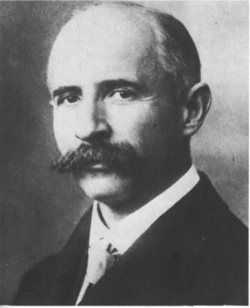
| Version | Summary | Created by | Modification | Content Size | Created at | Operation |
|---|---|---|---|---|---|---|
| 1 | Conner Chen | -- | 444 | 2022-12-05 01:52:29 |
Video Upload Options
1. Introduction
Walter Kaufmann (June 5, 1871 – January 1, 1947) was a Germany physicist. He is best known for the first experimental proof of the velocity dependence of mass, which was an important contribution to the development of modern physics, including special relativity.
2. Life
Of Jewish descent,[1] in 1890/91 Kaufmann studied mechanical engineering at the technical universities of Berlin and Munich. From 1892 he studied physics at the Universities of Berlin and Munich, attaining a doctorate in 1894. From 1896 he was an assistant at the physical institutes of the Universities of Berlin and Göttingen. Kaufmann habilitated in 1899 and became a professor extraordinarius of physics in at the University of Bonn. After further work at the Berliner Physikalisches Institut he became professor ordinarius for experimental physics and leader of the physical institute at the Albertina in Königsberg, where he taught until he retired in 1935. Later, he was guest lecturer at the University of Freiburg.[2]
3. Measurements of Velocity Dependence of Mass
Kaufmann's early work (1901–1903) confirmed for the first time the velocity dependence of the electromagnetic mass (later called relativistic mass) of the electron. However, the measurements were not accurate enough to differentiate between the Lorentz ether theory and that of Max Abraham.
At the end of 1905 Kaufmann carried out more accurate measurements. He was the first to discuss Albert Einstein's theory of special relativity and argued that, although Einstein's theory is based on quite different conditions and is logically more satisfying, it is observationally equivalent to Lorentz's theory. Therefore, he spoke of the "Lorentz-Einstein" theory. It is notable that Kaufmann himself interpreted his experimental results as confirmation of Abraham's theory, refuting the Lorentz-Einstein principle of relativity. For some years this weighed heavily against the latter. However, Kaufmann's results were criticized by Max Planck, Adolf Bestelmeyer (1906)[3] and Walter Ritz (1908).[4] The experiments were repeated by Alfred Bucherer (1908), Neumann (1914) and others, with results which appeared to confirm the Lorentz-Einstein theory and to disprove that of Abraham. However, it was pointed out later that the results were not accurate enough to distinguish between the theories.[3][5][6] The uncertainty continued until 1940,[7] when such experiments were accurate enough to rule out competing models. Today, the relativistic Lorentz-Einstein relations for momentum and energy are confirmed routinely in particle accelerators, see Tests of relativistic energy and momentum.
Note, however, that this uncertainty concerned only the relativistic mass of the electron. Even in 1917, investigations of the fine structure of the hydrogen lines provided confirmation of the Lorentz-Einstein formula, contradicting that of Abraham.[8]
References
- Silvan S. Schweber, Nuclear Forces: The Making of the Physicist Hans Bethe, Harvard University Press (2012), p. 92
- Hans Kangro (1977) (in de), Kaufmann, Walter, 11, Berlin: Duncker & Humblot, pp. 352–353, https://daten.digitale-sammlungen.de/0001/bsb00016328/images/index.html?seite=366
- Miller, A.I. (1981), Albert Einstein's special theory of relativity. Emergence (1905) and early interpretation (1905–1911), Reading: Addison–Wesley, ISBN 978-0-201-04679-3, https://archive.org/details/alberteinsteinss0000mill
- Ritz, W. (1908), "Recherches critiques sur l'Ėlectrodynamique Générale", Annales de Chimie et de Physique 13: 260–267, Bibcode: 1908AChPh..13..145R http://adsabs.harvard.edu/abs/1908AChPh..13..145R
- Zahn, C. T.; Spees, A. A. (1938), "A Critical Analysis of the Classical Experiments on the Variation of Electron Mass", Physical Review 53 (7): 511–521, doi:10.1103/PhysRev.53.511, Bibcode: 1938PhRv...53..511Z https://dx.doi.org/10.1103%2FPhysRev.53.511
- Janssen, M.; Mecklenburg, M. (2007), "From classical to relativistic mechanics: Electromagnetic models of the electron", in V. F. Hendricks, Interactions: Mathematics, Physics and Philosophy, Dordrecht: Springer, pp. 65–134, http://www.tc.umn.edu/~janss011/
- Rogers, M. M.; Rogers, F. (1940), "A Determination of the Masses and Velocities of Three Radium B Beta-Particles", Physical Review 57 (5): 379–383, doi:10.1103/PhysRev.57.379, Bibcode: 1940PhRv...57..379R https://dx.doi.org/10.1103%2FPhysRev.57.379
- "Die Relativitätstheorie", Encyclopädie der Mathematischen Wissenschaften 5 (2): 539–776, http://resolver.sub.uni-goettingen.de/purl?PPN360709672%7CLOG_0265 In English: Pauli, W. (1981). Theory of Relativity. 165. ISBN 978-0-486-64152-2.

Location: Elberfeld




